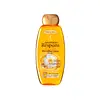What's inside
What's inside
 Key Ingredients
Key Ingredients

 Benefits
Benefits

 Concerns
Concerns

 Ingredients Side-by-side
Ingredients Side-by-side

Water
Skin ConditioningSodium Lauroyl Methyl Isethionate
CleansingCocamidopropyl Betaine
CleansingDisodium Laureth Sulfosuccinate
CleansingSodium Lauryl Sulfoacetate
CleansingGlycerin
HumectantArgania Spinosa Kernel Oil
EmollientHydrolyzed Wheat Protein
Skin ConditioningHelianthus Annuus Seed Oil
EmollientPhyllostachys Nigra Leaf Extract
Skin ConditioningGlycol Distearate
EmollientHydrolyzed Vegetable Protein Pg-Propyl Silanetriol
Skin ConditioningGuar Hydroxypropyltrimonium Chloride
Skin ConditioningSodium PCA
HumectantLauryl Methyl Gluceth-10 Hydroxypropyldimonium Chloride
Amodimethicone/Morpholinomethyl Silsesquioxane Copolymer
Sodium Chloride
MaskingTrideceth-5
EmulsifyingDehydroacetic Acid
PreservativePEG-150 Pentaerythrityl Tetrastearate
EmulsifyingQuaternium-95
UV AbsorberPPG-2 Hydroxyethyl Cocamide
EmulsifyingPropanediol
SolventPentaerythrityl Tetra-Di-T-Butyl Hydroxyhydrocinnamate
AntioxidantAlpha-Isomethyl Ionone
PerfumingBenzoic Acid
MaskingLactic Acid
BufferingPotassium Sorbate
PreservativeDisodium EDTA
Phenoxyethanol
PreservativeParfum
MaskingCI 47005
Cosmetic ColorantCI 61570
Cosmetic ColorantCI 42090
Cosmetic ColorantWater, Sodium Lauroyl Methyl Isethionate, Cocamidopropyl Betaine, Disodium Laureth Sulfosuccinate, Sodium Lauryl Sulfoacetate, Glycerin, Argania Spinosa Kernel Oil, Hydrolyzed Wheat Protein, Helianthus Annuus Seed Oil, Phyllostachys Nigra Leaf Extract, Glycol Distearate, Hydrolyzed Vegetable Protein Pg-Propyl Silanetriol, Guar Hydroxypropyltrimonium Chloride, Sodium PCA, Lauryl Methyl Gluceth-10 Hydroxypropyldimonium Chloride, Amodimethicone/Morpholinomethyl Silsesquioxane Copolymer, Sodium Chloride, Trideceth-5, Dehydroacetic Acid, PEG-150 Pentaerythrityl Tetrastearate, Quaternium-95, PPG-2 Hydroxyethyl Cocamide, Propanediol, Pentaerythrityl Tetra-Di-T-Butyl Hydroxyhydrocinnamate, Alpha-Isomethyl Ionone, Benzoic Acid, Lactic Acid, Potassium Sorbate, Disodium EDTA, Phenoxyethanol, Parfum, CI 47005, CI 61570, CI 42090
Water
Skin ConditioningSodium Laureth Sulfate
CleansingCoco-Betaine
CleansingCocamide Mipa
EmulsifyingSodium Chloride
MaskingSodium Benzoate
MaskingSodium Cocoate
CleansingSodium Hydroxide
BufferingPPG-5-Ceteth-20
EmulsifyingPEG-55 Propylene Glycol Oleate
PEG-60 Hydrogenated Castor Oil
EmulsifyingArgania Spinosa Kernel Oil
EmollientPolyquaternium-10
Salicylic Acid
MaskingLimonene
PerfumingCamellia Oleifera Seed Oil
Skin ConditioningLinalool
PerfumingBenzyl Alcohol
PerfumingAmodimethicone
Propylene Glycol
HumectantGeraniol
PerfumingCitronellol
PerfumingMethyl Cocoate
EmollientCitric Acid
BufferingLaureth-5 Carboxylic Acid
CleansingHexyl Cinnamal
PerfumingParfum
MaskingWater, Sodium Laureth Sulfate, Coco-Betaine, Cocamide Mipa, Sodium Chloride, Sodium Benzoate, Sodium Cocoate, Sodium Hydroxide, PPG-5-Ceteth-20, PEG-55 Propylene Glycol Oleate, PEG-60 Hydrogenated Castor Oil, Argania Spinosa Kernel Oil, Polyquaternium-10, Salicylic Acid, Limonene, Camellia Oleifera Seed Oil, Linalool, Benzyl Alcohol, Amodimethicone, Propylene Glycol, Geraniol, Citronellol, Methyl Cocoate, Citric Acid, Laureth-5 Carboxylic Acid, Hexyl Cinnamal, Parfum
 Reviews
Reviews

Ingredients Explained
These ingredients are found in both products.
Ingredients higher up in an ingredient list are typically present in a larger amount.
You may know this ingredient as argan oil. Argan Oil has antioxidant, hydrating, and soothing properties.
Studies have shown argan oil can help fight again radical damage from the sun. This makes it effective at preventing hyperpigmentation.
Large amounts of vitamin E found in argan oil helps the skin retain water. Argan oil also contains fatty acids such as linoleic acid, oleic acid, and palmitic acid. It is also a good source of lipids.
Another benefit of argan oil is skin-soothing. It can help reduce inflammation-related skin symptoms.
Argan Oil is effective at regulating sebum production in pores. This can make it effective at treating hormonal acne.
Traditionally, argan oil was used for its antibacterial and antifungal properties. However, argan oil contains fatty acids that may make it not fungal-acne safe.
Argan Trees are native to Morocco.
Learn more about Argania Spinosa Kernel OilParfum is a catch-all term for an ingredient or more that is used to give a scent to products.
Also called "fragrance", this ingredient can be a blend of hundreds of chemicals or plant oils. This means every product with "fragrance" or "parfum" in the ingredients list is a different mixture.
For instance, Habanolide is a proprietary trade name for a specific aroma chemical. When used as a fragrance ingredient in cosmetics, most aroma chemicals fall under the broad labeling category of “FRAGRANCE” or “PARFUM” according to EU and US regulations.
The term 'parfum' or 'fragrance' is not regulated in many countries. In many cases, it is up to the brand to define this term.
For instance, many brands choose to label themselves as "fragrance-free" because they are not using synthetic fragrances. However, their products may still contain ingredients such as essential oils that are considered a fragrance by INCI standards.
One example is Calendula flower extract. Calendula is an essential oil that still imparts a scent or 'fragrance'.
Depending on the blend, the ingredients in the mixture can cause allergies and sensitivities on the skin. Some ingredients that are known EU allergens include linalool and citronellol.
Parfum can also be used to mask or cover an unpleasant scent.
The bottom line is: not all fragrances/parfum/ingredients are created equally. If you are worried about fragrances, we recommend taking a closer look at an ingredient. And of course, we always recommend speaking with a professional.
Learn more about ParfumChances are, you eat sodium chloride every day. Sodium Chloride is also known as table salt.
This ingredient has many purposes in skincare: thickener, emulsifier, and exfoliator.
You'll most likely find this ingredient in cleansers where it is used to create a gel-like texture. As an emulsifier, it also prevents ingredients from separating.
There is much debate on whether this ingredient is comedogenic. The short answer - comedogenic ratings don't tell the whole story. Learn more about comegodenic ratings here.
The concensus about this ingredient causing acne seems to be divided. Research is needed to understand if this ingredient does cause acne.
Scrubs may use salt as the primary exfoliating ingredient.
Learn more about Sodium ChlorideWater. It's the most common cosmetic ingredient of all. You'll usually see it at the top of ingredient lists, meaning that it makes up the largest part of the product.
So why is it so popular? Water most often acts as a solvent - this means that it helps dissolve other ingredients into the formulation.
You'll also recognize water as that liquid we all need to stay alive. If you see this, drink a glass of water. Stay hydrated!
Learn more about Water